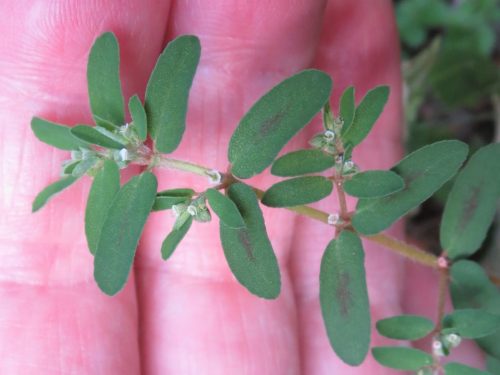Given how many new plants I’ve found in my yard this year, I’m beginning to think that if I wait long enough, every native and naturalized plant will eventually show up here. Not that all of them are the kinds of plant I want growing in my yard, but I appreciate the convenience. The pandemic has been keeping me at home, so it’s really quite nice of the plants to come to me.
Here is one of the latest additions to my yard.

My hand behind the plant offers some scale. Those flowers are tiny. Note the dark spot on some (but not all) leaves. I thought the spots looked purplish, but online sources describe them as “red” or “maroon.”
Picture taken 8/8/20.
This newbie is spotted spurge. It is among the nastiest of the nasty weeds, or at least that’s the impression I got from Google, where nearly every hit on “spotted spurge” was about how to get rid of the plant. I wouldn’t make any bets on it being the nastiest, though. The competition for that honor is fierce. We’ll have to wait and see how this plant measures up to other plants in my yard over time.
My Audubon wildflower guide didn’t include spotted spurge, which made identification harder. And I wish I’d been more careful when selecting a picture of the plant to use as my example. I focused on the tiny flowers and the apparent hairiness of the leaves and stem. Had I looked more carefully at all of the pictures, I would have noticed that some of the leaves had spots on them. That was a big clue that I overlooked. But it is good to keep in mind for future identification that the leaves don’t always have the spots.
Once I finally identified the plant, I got a strong feeling of deja-vu. I knew I had heard of spurge before. So I let my brain cook it for a bit, and soon I had my answer.
Two answers, actually. I have seen spurge mentioned in two notable places. The first was on my own blog (duh). Earlier this year I found a plant that I identified as a spurge, and I wrote, “I am unfamiliar with this plant, so I will have to do more research.” I never did the research, though, and I forgot all about it. That plant, by the way, was most likely cypress spurge.
The other place in which I’ve seen references to spurge is in books about foraging, where spurge is often mentioned as a poisonous look-alike for purslane. The two plants don’t look that much alike to me, but they do seem to spread along the ground in a similar way, and they apparently favor similar locations, so caution is merited. You can read more about the subject at this foraging website.
After reading about spurges, I recommend that everyone learn to recognize their local varieties. Spurges, it seems, are not friendly plants, and perhaps Google was on to something when it pointed me toward all those weed removal services. According to my Audubon guide, most spurges are poisonous. Some of them, such as cypress spurge, can cause contact dermatitis. Spurge nettle (a.k.a. tread softly) is a spurge that grows in the South. It has stinging hairs on it, like a nettle, and it can cause a bad rash.
But spurges are interesting, too. Some spurges look like cactuses, and some have fantastic names, such as devil’s backbone and Medusa’s head. I would like to know more about them. So, as I said that first time I mentioned spurge on my blog, I will have to do more research.

Pingback: Day 163: Random Sunday Thoughts | Blue-Footed Musings